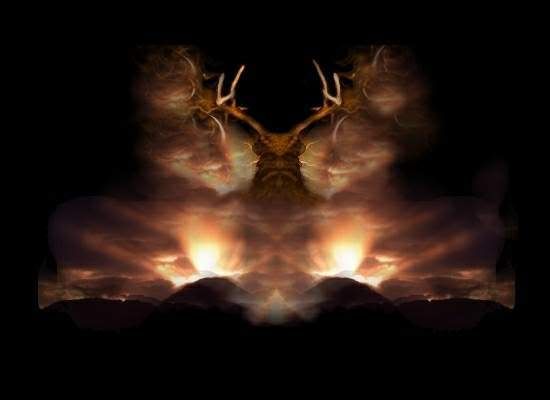
The following text is from the book 'Creed of Iron' (McVan; 1997), from a chapter entitled 'Horned Gods' (pages 38-41). Odin, or Wotan, was the chief god of the ancient Teutonic tribes; while Cernunnos was one of, if not the chief god of the Gallic people. Could they have come from a common source? Certainly there was a lot of cultural interchange between Teutons and Gauls. The Triquetra symbol, which has long been associated with Celtic/Gallic cultures, was used by some ancient peoples as a symbol of Odin. But wasn't Odin a Teutonic god? One of the well-known ancient depictions of Cernunnos is located on Gotland Island in Scandinavia. But wasn't Scandinavia prime Odinic territory? You can decide for yourself. It's possible that the answer could lay somewhere in the middle, or perhaps a later connection developed after the very ancient Norse migrated westward into Northern Europe tens of thousands of years ago.
HORNED GODS
It was no accident that the Horned Gods of the early Aryan pagan religions of Europe would later become vilified under the alien religious domination of Christianity. It has always been the nature of rival ideologies to demonize and destroy their opposition, and the storm to power by Christianity was certainly no exception.
In the ancient religions and arcane mysteries horns on the human head were always symbolic of divinity and high wisdom. The horned human image was, also, representative of virility and fertility. It was most common and natural to find such characterizations on many of the early deities. Only after the rise and imposition of Christianity with vigilant campaigns of death and torture did the nature-based pagan religions subsequently withdraw from the world stage of history. In so doing, the great esoteric wisdom and horned gods of ancient days were concealed from the vulgar. This hidden knowledge was later to become defined as "occult," which simply means "hidden." Occultism is, therefore, the study of the hidden, dissolving the diabolical implications of the term.
Through anthropological research one can trace the line of horned god prototypes back to Paleolithic times. The earliest known representation of such a figure is found painted on the interior walls of the Caverne des Trois Frères in Ariège, France and dates to the late Paleolithic period. Among an assemblage of animals, a figure of a man is clothed in the skin of a stag and wearing on his head the antlers of a stag. It seems evident from the relative position of all the figures that the man is dominant and that he is in the act of performing a ceremony.
 Though the stag-man is the most important of the horned figures of this early period, there are many smaller drawings of masked and horned men on bone and antler. The art of the Paleolithic period came to a sudden and complete end before the Neolithic era; it was utterly wiped out in Europe. The Neolithic Aryans have left few artistic remains; the surviving figures are predominantly female depictions.
Though the stag-man is the most important of the horned figures of this early period, there are many smaller drawings of masked and horned men on bone and antler. The art of the Paleolithic period came to a sudden and complete end before the Neolithic era; it was utterly wiped out in Europe. The Neolithic Aryans have left few artistic remains; the surviving figures are predominantly female depictions.
It is into the Bronze Age when the horned figure flourished again among the Indo-European (Aryan) tribes of Egypt, Mesopotamia and India. Horned gods were quite common in Mesopotamia, as in Babylon and Assyria. The copper head found in the gold tombs of Ur is believed to be earlier than the first Egyptian dynasty, displaying an advanced stage of metal-working.
When Alexander the Great raised himself above the kings of the earth and declared himself a "god," he wore a horned head piece as a symbol of his divinity. Polytheism appears to have arisen among the Aryan cultures, East and West, with the amalgamation of tribes, each with its own gods. The horned deities were prevalent throughout Greece and Rome.
The greatest horned god of pagan Gaul was known as Cernunnos. Images of this archetype date back as far as 20,000 years ago. The English parlance was "Herne" (i.e. Wotan), or more colloquially, "Old Hornie." In Northern Europe the ancient equivalent "Neck" or "Nick" was used, meaning "spirit." He had such a hold on the affections of the people that the Christian church was forced to accept him. And he was canonized as St. Nicholas, who in Cornwall still retains his horns. Few are aware today that Santa Claus has traditional and symbolic roots to Wotan.
Over the ages the names of deities change, but the essence more often remains the same. In addition to Cernunnos, the ancient Celtic god "Belenus" (Bel) was the most widely worshipped in all of Gaul and is still celebrated in the traditional festival of Beltane. Classical writers associate him with Apollo.
The early Greeks inherited from Mesopotamia a nature-personified god. "Ouranos," which means sky. Ouranos was later usurped as sky-god by his son "Kronos," later to be replaced by "Zeus." The Celtic god "Lugus" was characterized as the "shining one." Caesar identified him with the Roman god "Mercury," who was often compared to Wotan. The ancient deity of the Teutonic tribes was the sky-father "Tyr" (Tiw, Tew, Teu), later to be replaced by Wotan.
Of all the Aryan gods who have come and gone, Wotan remains consistent. Although subtle at times, Wotan is always ready to reemerge from the collective psyche of the Aryan folk. He is a god of many facets, which has no doubt helped him to endure through the ever-changing times. As the horned god, Herne the Hunter, the wearing of the staghorns is symbolic of the Ur-force, the primal power of the forest, as characterized by the Uruz rune. Wotan as Herne shares other similar characteristics with Cernunnos, as Lord of the Forest and the Animals. Wotan is, also, the spirit behind the leaf-faced "Green Man," who is widely represented in the fine arts and architecture of European culture.
Herne was known to be the mystic guide of Robin Hood. Also, we have the connection of Wotan, personified as Merlin, who was mystical seer to King Arthur.
 It is interesting to note as this point what is known as the "12 + 1" aspect of the ancient Aryan mysteries. Even Christianity used this gnostic numerology with the concept of Jesus and his 12 disciples. "Twelve plus one" personifies the sun and the twelve signs of the zodiac. Always there are either 12 prophets, 12 patriarchs or 12 disciples: King Arthur and the 12 Knights of the Round Table, Robin Hood and his 12 Merry Men, Charlemagne and his 12 Peers of the Supreme Council, Wotan and the 12 High Gods, Zeus and the 12 Great Gods of Olympus. The number 13 has profound gnostic significance. To give more examples, Romulus, who was both King and incarnate god to the Romans, went about surrounded by his 12 Lictors. And the Danish hero, Hrolf, was always accompanied by his 12 Berserks.
It is interesting to note as this point what is known as the "12 + 1" aspect of the ancient Aryan mysteries. Even Christianity used this gnostic numerology with the concept of Jesus and his 12 disciples. "Twelve plus one" personifies the sun and the twelve signs of the zodiac. Always there are either 12 prophets, 12 patriarchs or 12 disciples: King Arthur and the 12 Knights of the Round Table, Robin Hood and his 12 Merry Men, Charlemagne and his 12 Peers of the Supreme Council, Wotan and the 12 High Gods, Zeus and the 12 Great Gods of Olympus. The number 13 has profound gnostic significance. To give more examples, Romulus, who was both King and incarnate god to the Romans, went about surrounded by his 12 Lictors. And the Danish hero, Hrolf, was always accompanied by his 12 Berserks.
It is through an understanding of world history that Aryan man sees himself and by the comprehension of the mysteries that he knows himself. Wotanism is the incarnation of the indestructible collective soul of the Aryan race.
Since the first horned god was scrawled on the wall of a cave in pre-historic times, the blood essence of our ancestors has continued through the chain of the generations which bind us in a great linkage of destiny, beat and time.
.